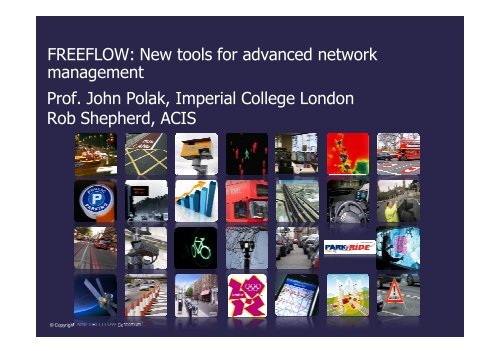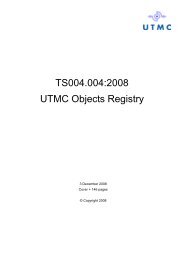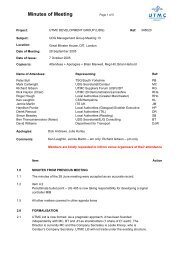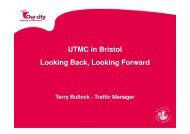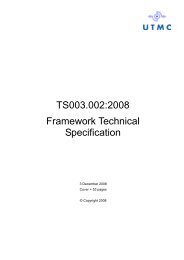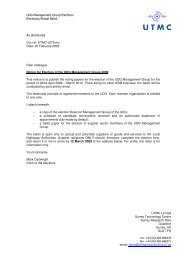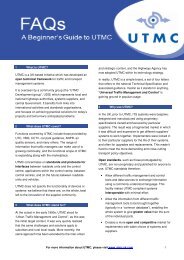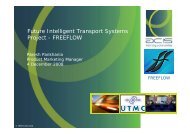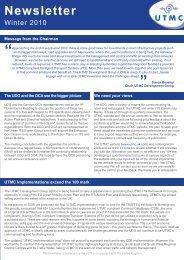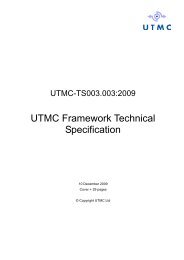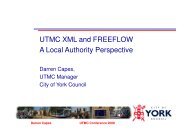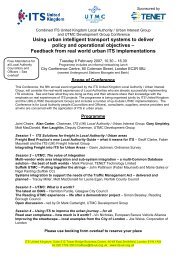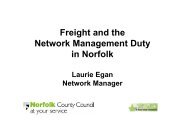FREEFLOW: New tools for advanced network management ... - UTMC
FREEFLOW: New tools for advanced network management ... - UTMC
FREEFLOW: New tools for advanced network management ... - UTMC
Create successful ePaper yourself
Turn your PDF publications into a flip-book with our unique Google optimized e-Paper software.
<strong>FREEFLOW</strong>: <strong>New</strong> <strong>tools</strong> <strong>for</strong> <strong>advanced</strong> <strong>network</strong><br />
<strong>management</strong><br />
Prof. John Polak, Imperial College London<br />
Rob Shepherd, ACIS<br />
© Copyright 2010 <strong>FREEFLOW</strong> Consortium
<strong>FREEFLOW</strong> – Overview<br />
− Motivation and project overview<br />
− Data Warehouse<br />
− Intelligent Decision Support<br />
− Deployment<br />
− Conclusions<br />
© Copyright 2010 <strong>FREEFLOW</strong> Consortium
<strong>FREEFLOW</strong> – Background<br />
− Rapid pace of innovation in:<br />
− data sources (e.g., pervasive GPS, increasingly extensive CCTV)<br />
− <strong>network</strong> modelling <strong>tools</strong><br />
− decision support technologies<br />
− channels of communication with individual traveller<br />
− Provides enormous scope <strong>for</strong> innovation in <strong>network</strong><br />
<strong>management</strong> and traveller in<strong>for</strong>mation<br />
− To meet new challenges in transport policy<br />
− But existing strategies <strong>for</strong> <strong>network</strong> <strong>management</strong> do not fully<br />
exploit these capabilities, and remain largely reactive<br />
© Copyright 2010 <strong>FREEFLOW</strong> Consortium
<strong>FREEFLOW</strong> – Vision<br />
− Develop a plat<strong>for</strong>m that integrates latest developments in<br />
data, models, decision support and dissemination<br />
technologies<br />
− Modular, pick-n-mix. Not one size fits all<br />
− Driven by explicit analysis of user requirements<br />
− Build on, not duplicate, existing investments e.g., in the UK’s<br />
<strong>UTMC</strong> architecture<br />
− Develop services, <strong>tools</strong> and approaches that can be used in<br />
the UK and elsewhere<br />
© Copyright 2010 <strong>FREEFLOW</strong> Consortium
<strong>FREEFLOW</strong> – Project and Partners<br />
Sponsors<br />
Demonstrators<br />
Industrial<br />
Academia<br />
© Copyright 2010 <strong>FREEFLOW</strong> Consortium
<strong>FREEFLOW</strong> – Key Elements<br />
− Sensor processing (e.g., enhanced signal processing)<br />
− Data warehouse (e.g., how do I access all these data), data sharing and<br />
dissemination using open standard interfaces with real-time capability<br />
− Sensor data fusion (e.g., combining CCTV, ILD, GPS, ANPR data <strong>for</strong><br />
<strong>network</strong> per<strong>for</strong>mance estimation)<br />
− Network state estimation and prediction (e.g., where are the<br />
queues/incidents, are they growing or clearing)<br />
− Strategy development and selection (e.g., what should we do, what<br />
worked in the past, what does modelling tell us)<br />
− Tools <strong>for</strong> integration, visualisation and decision support (e.g., how do I get<br />
at and use all this in<strong>for</strong>mation)<br />
© Copyright 2010 <strong>FREEFLOW</strong> Consortium
<strong>FREEFLOW</strong> – Data Warehouse Context<br />
Kent and York<br />
<strong>FREEFLOW</strong> Data Warehouse<br />
Other<br />
Applications<br />
Existing<br />
<strong>UTMC</strong><br />
CDB<br />
Data<br />
Source<br />
<strong>UTMC</strong> CDB<br />
Import<br />
Adapter<br />
Direct Data<br />
Source<br />
Adapters<br />
<strong>UTMC</strong> Compliant<br />
Database<br />
Adapter<br />
Manager<br />
UDG XML SIRI <strong>UTMC</strong><br />
IDS<br />
ODS<br />
© Copyright 2010 <strong>FREEFLOW</strong> Consortium
<strong>FREEFLOW</strong> – Data Warehouse Context TfL<br />
TDES, (Traffic Signal Timing)<br />
LDIS, (VMS)<br />
LTIS, (Traffic In<strong>for</strong>mation)<br />
IRID, (Image Recognition (CCTV))<br />
SFM, (Fault/Asset Management)<br />
SOX-D, (UTC/SCOOT Data)<br />
Real-time<br />
Data<br />
Sources<br />
LCAP, (ANPR (Journey Time))<br />
OUTCAST, (Historic UTC and<br />
Traffic Signal Data)<br />
JTE, (Journey Time Estimator –<br />
GPS and Loop Data)<br />
Historic<br />
Data<br />
Sources<br />
<strong>UTMC</strong> CDB (COMET)<br />
<strong>UTMC</strong><br />
Input<br />
Adapters<br />
<strong>UTMC</strong><br />
Output<br />
Adapters<br />
<strong>UTMC</strong><br />
Input<br />
Adapters<br />
Data<br />
Warehouse<br />
UDG XML SIRI <strong>UTMC</strong><br />
Other<br />
Applications<br />
ODS<br />
IDS<br />
© Copyright 2010 <strong>FREEFLOW</strong> Consortium
<strong>FREEFLOW</strong> – Data Warehouse Design<br />
<strong>UTMC</strong> CDB<br />
Import Adapters<br />
Direct Data<br />
Source Adapters<br />
Adapter Manager<br />
Output Cache<br />
Database Cache<br />
Web Server<br />
Database Manager<br />
© Copyright 2010 <strong>FREEFLOW</strong> Consortium<br />
<strong>UTMC</strong> Compliant<br />
Database
<strong>FREEFLOW</strong> – IDS Overview<br />
− The ‘intelligence’ in IDS resides in four dimensions:<br />
− Being able to fully utilise all available data sources<br />
− Being able to identify and predict potential problems<br />
− Being able to systematically use past experience to respond<br />
to problems<br />
− To view <strong>network</strong> <strong>management</strong> and traveller in<strong>for</strong>mation as<br />
an integrated activity<br />
© Copyright 2010 <strong>FREEFLOW</strong> Consortium
<strong>FREEFLOW</strong> – IDS Overview<br />
Data<br />
Interface<br />
State<br />
Estimator<br />
Rule-based<br />
Triggers<br />
IDS<br />
Rules<br />
Engine<br />
Rule-based<br />
Interventions<br />
Pattern<br />
Matcher<br />
Intervention<br />
Evaluator (PI)<br />
Intervention<br />
Lookup<br />
Alert +<br />
Intervention<br />
Potential Causes<br />
of Alert<br />
Events &<br />
Faults<br />
Lookup<br />
Historic Traffic<br />
Sensor Data<br />
(CMM)<br />
Historic<br />
Traffic Control<br />
Interventions<br />
Historic<br />
Events &<br />
Faults<br />
© Copyright 2010 <strong>FREEFLOW</strong> Consortium
<strong>FREEFLOW</strong> – IDS Flowchart<br />
Real World<br />
Sensors<br />
IDS<br />
State Estimator<br />
State Prediction<br />
Intervention<br />
Needed<br />
Yes<br />
Strategy Selection<br />
Intervention<br />
Knowledgebase<br />
Historic<br />
Traffic<br />
Data<br />
© Copyright 2010 <strong>FREEFLOW</strong> Consortium
<strong>FREEFLOW</strong> – IDS – a simple state estimator<br />
− Input: Flow and occupancy data from ILDs<br />
− Output: In its simplest <strong>for</strong>m, categorises the current traffic<br />
state (flow, occupancy) as congested or uncongested)<br />
© Copyright 2010 <strong>FREEFLOW</strong> Consortium
<strong>FREEFLOW</strong> – IDS - rules engine<br />
− Pattern matcher determines which of the IDS subcomponents<br />
to invoke using<br />
− The output of the state estimator<br />
− Data from traffic sensors<br />
− The rules engine chooses one of the following options<br />
− Recommends pre-selected traffic control interventions <strong>for</strong><br />
known traffic problems<br />
− Invokes the pattern-matcher <strong>for</strong> problems not defined in<br />
the rule-set<br />
© Copyright 2010 <strong>FREEFLOW</strong> Consortium
<strong>FREEFLOW</strong> – IDS - pattern matcher<br />
− The idea behind pattern-matcher – learn from past<br />
experience (what has worked and what has not)<br />
− Objective: find past traffic states with similar spatial pattern<br />
and severity<br />
− Successful interventions during similar traffic problems in the<br />
past are potential solutions to the current problem<br />
© Copyright 2010 <strong>FREEFLOW</strong> Consortium
<strong>FREEFLOW</strong> – IDS – interventions & events<br />
− Data from similar past problem states can provide successful<br />
past interventions <strong>for</strong> similar problems<br />
− Interventions can be quantitatively ranked using a PI metric<br />
− Historic data can also reveal potential causes of the problem<br />
− Traffic incidents. e.g. broken down vehicle<br />
− Equipment failure. e.g. traffic light faults<br />
− Makes use of the historic archive of traffic control, incident<br />
and fault logs available in many cities<br />
© Copyright 2010 <strong>FREEFLOW</strong> Consortium
<strong>FREEFLOW</strong> – Demonstrators<br />
− York<br />
− <strong>UTMC</strong> history and investment to build on<br />
− Bus service reliability is key priority<br />
− Demonstrations on multiple radials<br />
− Kent<br />
− <strong>UTMC</strong> history too<br />
− Motorways around Maidstone impact on <strong>network</strong><br />
− Active <strong>management</strong> of urban/interurban interface during incidents<br />
− London<br />
− Different UTC architecture<br />
− Very large authority<br />
− Active <strong>management</strong> at Hyde Park Corner<br />
− Data Warehouses exist at all three demonstration sites<br />
© Copyright 2010 <strong>FREEFLOW</strong> Consortium
<strong>FREEFLOW</strong> – Data Warehouse<br />
− In deploying the Data Warehouse we encountered certain<br />
challenges:<br />
− Extracting data from existing in-situ <strong>UTMC</strong> Common<br />
Databases using repeated request response cycles is not<br />
efficient<br />
− The Databases were never designed to support this<br />
− Interfaces that are not open standards do impede data<br />
exchange<br />
© Copyright 2010 <strong>FREEFLOW</strong> Consortium
<strong>FREEFLOW</strong> – Data Warehouse<br />
− City of York<br />
− SCOOT data, Car parks, VMS, roadworks, bus Transport<br />
Link, (bus Transport Route)<br />
− Holds historical data back to August 2009<br />
− Car Park Dynamic – 438,000 records<br />
− Kent County Council<br />
− TL ANPR, VMS, Flow, Speed, Occupancy<br />
− To add when XML publisher is upgraded:<br />
− Roadworks, Incidents, Car Parks, Accidents, MIDAS<br />
− VMS 215,000 records since June 2010<br />
− TL ANPR 277,000 records since June 2010<br />
© Copyright 2010 <strong>FREEFLOW</strong> Consortium
FREFLOW – Data Warehouse<br />
− Transport <strong>for</strong> London<br />
− Traffic Signal Timing, LDIS, (VMS), LTIS, (Traffic<br />
In<strong>for</strong>mation), IRID, (Image Recognition (CCTV), Fault/Asset<br />
Management, UTC/SCOOT Data, LCAP, (ANPR (Journey<br />
Time)), OUTCAST, (Historic UTC and Traffic Signal Data),<br />
Journey Time Estimator (based on GPS and Loop Data)<br />
− 2,500,000 records per day<br />
© Copyright 2010 <strong>FREEFLOW</strong> Consortium
<strong>FREEFLOW</strong> – Conclusions<br />
− Data Warehouse<br />
− Has proven the UDG XML SIRI interface <strong>for</strong> <strong>UTMC</strong> data object<br />
exchange<br />
− There is now a proven open standard that allows the easy<br />
sharing of data in line with current IT industry practice<br />
− The use of defined XML schema as part of the standard allows<br />
automatic code generation to be used to speed up<br />
implementation<br />
− IDS<br />
− Integrates state of the art modelling with rule based protocols<br />
− Fully exploits a wide range of data sources<br />
− Supports institutional learning<br />
© Copyright 2010 <strong>FREEFLOW</strong> Consortium


